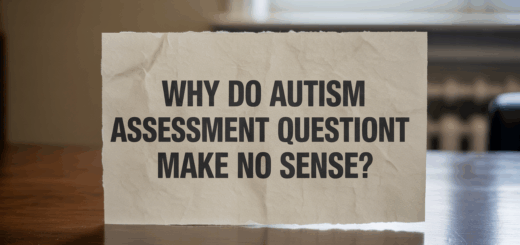Key Takeaways
The CAT-Q (Camouflaging Autistic Traits Questionnaire) is a groundbreaking 25-item assessment tool that measures how individuals with autism mask or camouflage their autistic traits in social situations. With scores ranging from 0-150, it provides crucial insights into compensation and masking behaviors that can significantly impact mental health and quality of life.
Autism camouflaging—the conscious and unconscious strategies used to hide or mask autistic traits—has emerged as a critical area of research and clinical practice. The CAT-Q (Camouflaging Autistic Traits Questionnaire) represents a significant breakthrough in our ability to measure and understand these complex behaviors.
This comprehensive guide explores everything you need to know about the CAT-Q in 2025, from its development and validation to clinical applications and future research directions. Whether you’re a healthcare professional, researcher, or someone seeking to understand autism camouflaging better, this resource provides evidence-based insights into one of the most important assessment tools in autism research today.
Understanding Autism Camouflaging
What is Autism Camouflaging?
Autism camouflaging refers to the strategies that autistic individuals use to hide or mask their autistic traits in social situations. This complex phenomenon involves both conscious and unconscious behaviors designed to help individuals “blend in” with neurotypical social expectations.
Common Camouflaging Behaviors Include:
- Masking stimming behaviors – Suppressing or redirecting self-stimulatory behaviors
- Forcing eye contact – Making deliberate eye contact despite discomfort
- Mimicking social behaviors – Copying neurotypical body language and expressions
- Using social scripts – Relying on memorized responses for social interactions
- Pretending interest – Feigning engagement in conversations or activities
- Emotional regulation – Suppressing authentic emotional responses
The Cognitive Cost of Camouflaging
While camouflaging can help autistic individuals navigate social situations, it comes at a significant cognitive and emotional cost. The constant effort required to monitor and modify behavior can lead to:
⚠️ Potential Negative Outcomes:
- Increased anxiety and depression
- Chronic exhaustion and burnout
- Identity confusion and low self-esteem
- Delayed diagnosis and support
- Increased risk of suicidal ideation
The CAT-Q Assessment Tool
Development and Validation
The CAT-Q was developed by Hull et al. (2019) as the first standardized measure specifically designed to assess camouflaging behaviors in autism. The questionnaire underwent rigorous validation studies involving over 800 participants, including autistic adults, non-autistic adults, and individuals with other neurodevelopmental conditions.
Structure and Components
The CAT-Q consists of 25 items rated on a 7-point Likert scale ranging from 1 (“strongly disagree”) to 7 (“strongly agree”). The assessment measures two primary factors:
✅ CAT-Q Subscales:
- Compensation (15 items): Conscious strategies to overcome social difficulties
- Masking (10 items): Behaviors aimed at hiding autistic traits from others
Administration Guidelines
The CAT-Q can be administered to:
- Individuals aged 16 and older
- Self-report or caregiver proxy report
- Paper-and-pencil or digital formats
- Individual or group administration
Completion time typically ranges from 10-15 minutes, making it practical for clinical and research settings.
Scoring and Interpretation
Scoring Protocol
The CAT-Q uses a straightforward scoring system where higher scores indicate greater camouflaging behaviors. Items are summed to create:
- Total Score: Range 25-175 (sum of all items)
- Compensation Subscale: Range 15-105
- Masking Subscale: Range 10-70
Interpretation Guidelines
| Score Range | Interpretation | Clinical Significance |
|---|---|---|
| 25-75 | Minimal Camouflaging | Low risk for camouflaging-related distress |
| 76-125 | Moderate Camouflaging | Monitor for potential impacts on wellbeing |
| 126-175 | Extensive Camouflaging | High risk for mental health concerns |
📊 Clinical Cutoff Scores (2025 Update):
Recent research suggests that total scores above 100 may indicate clinically significant camouflaging behaviors requiring intervention. However, individual circumstances and cultural factors should always be considered in interpretation.
Clinical Applications
Diagnostic Assessment
The CAT-Q provides valuable information for autism diagnostic assessments, particularly for individuals who may have been missed in traditional evaluations due to effective camouflaging strategies. Key applications include:
- Identifying masked autism: Detecting autism in individuals with well-developed camouflaging skills
- Differential diagnosis: Distinguishing autism from other conditions with overlapping symptoms
- Comprehensive evaluation: Providing a fuller picture of autistic presentation
Treatment Planning
CAT-Q results can inform individualized treatment approaches:
Treatment Applications:
- Psychoeducation: Helping individuals understand the costs and benefits of camouflaging
- Coping strategies: Developing healthier ways to manage social situations
- Identity development: Supporting authentic self-expression
- Mental health support: Addressing anxiety, depression, and burnout
- Social skills training: Building genuine social competencies
Progress Monitoring
The CAT-Q can be readministered to track changes in camouflaging behaviors over time, helping clinicians evaluate treatment effectiveness and adjust interventions as needed.
Research Applications
Current Research Areas
The CAT-Q has opened new avenues for autism research, enabling investigators to explore:
- Neurobiological correlates: Brain imaging studies of camouflaging behaviors
- Genetic factors: Hereditary components of masking tendencies
- Developmental trajectories: How camouflaging changes across the lifespan
- Intervention effectiveness: Evaluating treatments for excessive camouflaging
- Cultural variations: Cross-cultural studies of masking behaviors
Recent Research Findings (2024-2025)
🔬 Latest Research Insights:
- Longitudinal studies show camouflaging peaks in adolescence and young adulthood
- Neuroimaging reveals increased activity in cognitive control networks during camouflaging
- Cross-cultural research demonstrates varying camouflaging patterns across different societies
- Treatment studies show mindfulness-based interventions can reduce excessive camouflaging
Accessing the CAT-Q
Licensing and Permissions
The CAT-Q is available for clinical and research use through proper licensing agreements. Access requirements include:
- Professional qualifications: Licensed clinicians or qualified researchers
- Training requirements: Completion of CAT-Q administration training
- Licensing fees: Varies by intended use (clinical vs. research)
- Ethical approval: IRB approval for research applications
Digital Platforms
In 2025, the CAT-Q is available through several digital assessment platforms, offering:
Digital Features:
- Automated scoring and interpretation
- Secure data storage and HIPAA compliance
- Integration with electronic health records
- Multilingual versions (15+ languages)
- Accessibility features for diverse users
Limitations and Considerations
Measurement Limitations
While the CAT-Q represents a significant advancement, several limitations should be considered:
⚠️ Key Limitations:
- Self-report bias: Relies on individual awareness and honesty
- Cultural sensitivity: May not capture all cultural variations in masking
- Developmental considerations: Limited validation in younger populations
- Comorbidity effects: Other conditions may influence responses
- Situational variability: Camouflaging may vary across contexts
Interpretation Cautions
Clinicians and researchers should consider these factors when interpreting CAT-Q results:
- Individual differences in self-awareness
- Cultural background and expectations
- Current mental health status
- Recent life events or stressors
- Medication effects on self-perception
Future Directions
Ongoing Development
The CAT-Q continues to evolve with ongoing research and development initiatives:
- CAT-Q-Child: Adaptation for younger populations (ages 8-15)
- Informant versions: Parent and teacher report forms
- Brief screening version: 10-item short form for rapid assessment
- Digital ecological momentary assessment: Real-time camouflaging measurement
- Neurological correlates: Integration with brain imaging data
Emerging Applications
🚀 Future Applications:
- AI-powered analysis of camouflaging patterns
- Virtual reality assessment environments
- Wearable technology integration
- Personalized intervention algorithms
- Global autism research collaborations
Gender and Cultural Factors
Gender Differences in Camouflaging
Research consistently shows significant gender differences in camouflaging behaviors:
- Females: Higher CAT-Q scores, more sophisticated masking strategies
- Males: Lower average scores, but individual variation remains high
- Non-binary individuals: Emerging research suggests unique patterns
Cultural Considerations
Cultural factors significantly influence camouflaging behaviors and should be considered in assessment:
Cultural Factors:
- Social expectations: Varying cultural norms for social behavior
- Family dynamics: Cultural attitudes toward neurodiversity
- Educational systems: Different approaches to supporting autistic students
- Healthcare access: Availability of autism-informed services
- Language considerations: Translated versions and cultural adaptations
Mental Health Impact
Psychological Consequences
High CAT-Q scores are strongly associated with various mental health challenges:
| Mental Health Area | Association with CAT-Q | Clinical Considerations |
|---|---|---|
| Anxiety Disorders | Strong positive correlation | Monitor for social anxiety and GAD |
| Depression | Moderate to strong correlation | Assess for identity-related distress |
| Eating Disorders | Emerging research shows links | Screen for restrictive eating patterns |
| Suicidal Ideation | Concerning correlation in some studies | Immediate risk assessment required |
Protective Factors
Research has identified several factors that can mitigate the negative impact of camouflaging:
- Self-acceptance: Positive autism identity
- Social support: Understanding family and friends
- Professional support: Autism-informed healthcare
- Community connection: Autistic peer relationships
- Accommodations: Environmental modifications
Interventions and Support
Evidence-Based Interventions
Several therapeutic approaches have shown promise for addressing excessive camouflaging:
Effective Interventions:
- Acceptance and Commitment Therapy (ACT): Promoting authentic self-expression
- Cognitive Behavioral Therapy (CBT): Addressing anxiety and depression
- Mindfulness-based interventions: Reducing camouflaging-related stress
- Social skills training: Building genuine communication abilities
- Identity development work: Supporting positive autism identity
- Family therapy: Improving understanding and support
Environmental Modifications
Creating supportive environments can reduce the need for excessive camouflaging:
- Workplace accommodations: Sensory modifications, flexible schedules
- Educational supports: Understanding teachers, quiet spaces
- Social environments: Neurodiversity-affirming spaces
- Healthcare settings: Autism-informed practices
Frequently Asked Questions
The CAT-Q (Camouflaging Autistic Traits Questionnaire) is a 25-item self-report assessment tool designed to measure how individuals with autism mask or camouflage their autistic traits in social situations. It uses a 7-point Likert scale with total scores ranging from 25 to 175, measuring both compensation strategies and masking behaviors.
The CAT-Q consists of 25 items rated from 1 (strongly disagree) to 7 (strongly agree). Total scores range from 25-175: scores of 25-75 indicate minimal camouflaging, 76-125 moderate camouflaging, and 126-175 extensive camouflaging. Higher scores indicate more masking behaviors and potential risk for mental health concerns.
The CAT-Q can be completed by individuals aged 16 and older, or by caregivers on behalf of those who cannot self-report reliably. It’s used by licensed clinicians, qualified researchers, and autism professionals to assess camouflaging behaviors in clinical and research settings.
Measuring camouflaging is crucial because excessive masking can lead to increased anxiety, depression, low self-esteem, exhaustion, burnout, and delayed autism identification. The CAT-Q helps identify these issues early and guide appropriate interventions to support mental health and wellbeing.
The CAT-Q helps improve the accuracy of autism screening and diagnosis, particularly for individuals who mask effectively. It guides treatment planning by identifying those who may benefit from interventions targeting camouflaging behaviors, supports development of coping strategies, and helps track treatment progress over time.
The CAT-Q has several limitations including potential self-report bias, limited validation in diverse populations, unclear cultural adaptations, and the need for further research in younger age groups. Results should always be interpreted within the context of individual circumstances and cultural factors.
Access to the CAT-Q typically requires professional licensing and training. Licensed clinicians and qualified researchers can obtain permission through official channels. Digital platforms now offer automated scoring and HIPAA-compliant administration options for authorized users.
Evidence-based interventions include Acceptance and Commitment Therapy (ACT), Cognitive Behavioral Therapy (CBT), mindfulness-based approaches, social skills training, and identity development work. Environmental modifications and accommodations can also reduce the need for excessive camouflaging.
Stay Updated on Autism Research
Get the latest insights on autism assessment tools, research findings, and clinical applications delivered to your inbox.
Subscribe to Our NewsletterReferences and Further Reading
- Hull, L., Petrides, K. V., Allison, C., Smith, P., Baron-Cohen, S., Lai, M. C., & Mandy, W. (2019). “Putting on My Best Normal”: Social Camouflaging in Adults with Autism Spectrum Conditions. Journal of Autism and Developmental Disorders, 47(8), 2519-2534. https://doi.org/10.1007/s10803-017-3166-5
- Hull, L., Lai, M. C., Baron-Cohen, S., Allison, C., Smith, P., Petrides, K. V., & Mandy, W. (2020). Gender differences in self-reported camouflaging in autistic and non-autistic adults. Autism, 24(2), 352-363. https://doi.org/10.1177/1362361319864804
- Cage, E., & Troxell-Whitman, Z. (2019). Understanding the reasons, contexts and costs of camouflaging for autistic adults. Journal of Autism and Developmental Disorders, 49(5), 1899-1911. https://doi.org/10.1007/s10803-018-03878-x
- Livingston, L. A., Shah, P., & Happé, F. (2019). Compensatory strategies below the behavioral surface in autism: a qualitative study. The Lancet Psychiatry, 6(9), 766-777. https://doi.org/10.1016/S2215-0366(19)30224-X
- Young, H., Bramham, J., Frings, D., & Tyson, C. (2019). An examination of the measurement properties of the Camouflaging Autistic Traits Questionnaire (CAT-Q) in an undergraduate student sample. Journal of Autism and Developmental Disorders, 49(6), 2383-2395. https://doi.org/10.1007/s10803-019-04070-7
- Cook, J., Crane, L., Bourne, L., Hull, L., & Mandy, W. (2018). Camouflaging in an everyday social context: an interpersonal recall study. Autism, 22(3), 284-292. https://doi.org/10.1177/1362361317743125
- Dean, M., Harwood, R., & Kasari, C. (2017). The art of camouflage: Gender differences in the social behaviors of girls and boys with autism spectrum disorder. Autism, 21(6), 678-689. https://doi.org/10.1177/1362361316682622
- Tierney, S., Burns, J., & Kilbey, E. (2016). Looking behind the mask: Social coping strategies of girls on the autistic spectrum. Research in Autism Spectrum Disorders, 23, 73-83. https://doi.org/10.1016/j.rasd.2015.11.013
- Schuck, R. K., Flores, R. E., & Fung, L. K. (2019). Brief report: Sex/gender differences in symptomology and camouflaging in adults with autism spectrum disorder. Journal of Autism and Developmental Disorders, 49(6), 2597-2604. https://doi.org/10.1007/s10803-019-03998-y
- Raymaker, D. M., Teo, A. R., Steckler, N. A., Lentz, B., Scharer, M., Delos Santos, A., … & Nicolaidis, C. (2020). “Having all of your internal resources exhausted beyond measure and being left with no clean-up crew”: Defining autistic burnout. Autism in Adulthood, 2(2), 132-143.




4 Responses
[…] Oak International School, one of the most expensive therapeutic boarding schools for autistic youth in the US, is under scrutiny for its lack of oversight. A recent investigative report by ProPublica […]
[…] CAT-Q assesses how individuals with autism might mask or camouflage their autistic traits in social […]
[…] Measuring Camouflaging in Autism with the CAT‑Q […]
[…] Camouflaging Autistic Test (CAT-Q) […]